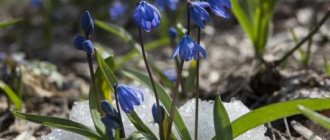For gardeners who use vertical gardening in landscape design, morning glory will come in handy.
This flowering vine thickly wraps around the supports and, even in the absence of buds, looks very decorative due to its dense foliage. Morning glory flowers look like delicate funnel-shaped gramophones, reminiscent of a symbiosis of nasturtium and fragrant tobacco.
This is an annual climbing plant from the Convolvulaceae family. Its homeland is Mexico and tropical America. With quality care, growing morning glory is also possible in the middle zone.
general information
It is difficult to give a general description of morning glory, because its varieties are very different. But most of them are bindweeds or vines, with delicate funnel-shaped flowers and large lobed leaves. The most common colors are all shades of white, blue and purple.
Morning glory buds open in the morning as soon as the sun's rays hit them. So when you wake up, a lush flowering carpet will already be waiting for you. There are also decorative deciduous varieties, but they are not very common.
Morning glory blooms by mid-summer, and blooms in waves until the first frost. The diameter of the open bud reaches 12 cm. Small tubers can form on the rhizomes, and in some regions they are even eaten.
Photo: pinterest.ru
Growing indoors
If you plan to plant morning glory indoors, make sure there is a chicken wire or trellis in front of a sunny window for them to climb. Fortunately, morning glory as a houseplant will bloom profusely all year round.
For best results, make sure the soil is moist, not soggy, and has good drainage. Don't fertilize too much or you'll end up with more foliage than flowers.
Types of morning glory
There are more than 300 types of morning glory, but not all of them are so elegant and decorative. We talk about several of the most popular ones that are loved by gardeners and breeders.
Morning glory Nile
A tall, branched vine with soft shoots grows up to 3 m. In contrast to the dark green leaves, funnel-shaped flowers in blue, pink or red shades bloom. Petals can be semi-double or corrugated.
Photo: flo.discus-club.ru
Tricolor morning glory
This variety is loved for its large spreading vine, which can even form a giant bush. The flowers are collected in small groups and can reach up to 15 cm in diameter.
Photo: liveinternet.ru
Moonflowering morning glory
Its long, thin shoots with heart-shaped leaves stretch up to 6 m. This is a very interesting variety that blooms at night or on cloudy days.
Photo: semenasklad.ru
Blue morning glory
A tall variety with large pale blue buds. The liana grows quickly, but, unfortunately, the flowers close by mid-day.
Photo: zen.yandex.ua
Morning glory Kvamoklit
A very original look, which is easily recognized by the characteristic shape of the carved leaves. The flowers are small, up to 2 cm, but also very unusual and look like stars. Gradually the bud changes color from red to white.
Photo: ok.ru
Morning glory Mina Lobata
Another original variety with flexible strong shoots and large wrinkled leaves. The buds of this morning glory are small and bright, but they hardly open. But they change color from red to yellow.
Photo: davisla.wordpress.com
Osteospermum (50 photos): types, planting and care in open ground
Description of the plant
The origin of the flower's name is not as beautiful and romantic as the flower itself. From Latin, Ipomoea literally means “worm-like.” Morning glory belongs to the Convolvulaceae family. It is very numerous, including up to 500 species of representatives with different colors of flowering buds, leaf shapes, and the ability to grow on vertical surfaces.
Different varieties can be combined by planting together, then the background that morning glory creates will be multi-colored and varied.
In nature, perennial morning glory grows in southern countries. Its close “relative” is wild bindweed.
The crop chooses trees and shrubs growing nearby as supports; in populated areas it clings to cracks in the walls of houses, fences, and enclosures.
At the dacha, flower growers most often grow an annual species. But in the southern regions, for example in the Crimea, perennial specimens can also be grown.
Morning glory has a thin branching stem. The heart-shaped leaves are green and located on long petioles.
Flowers also form on petioles and droop slightly. The morning glory trunk does not become woody and grows up to 4 meters in length.
After flowering, in place of the buds, seed pods are formed, which, when ripened, scatter seeds.
Morning glory care
Most varieties of morning glory are completely unpretentious in care. So if you are looking for a beautiful ornamental plant that you can plant and forget about it for most of the time, this is your choice!
Temperature
The most comfortable temperature for morning glory is about 20 degrees. It does not tolerate frost well, so even perennial varieties in our latitudes are cultivated as annuals.
Photo: fotokto.ru
Lighting
It is best to choose sunny areas, because bindweed grows slowly and sluggishly in the shade. However, a light openwork shadow from the tree crown will not become a significant problem.
Photo: 2sotki.ru
Watering
Morning glory does not tolerate drought very well because it has nowhere to store water supplies. So regular and systematic watering is needed, but without stagnation of moisture at the roots.
Photo: golos.id
The soil
The ideal soil for morning glory is moderately moist, nutritious and necessarily loose and breathable. You can plant bindweed on sandy soils, but then add a little black soil or compost.
Photo: ogorod-bez-hlopot.ru
Fertilizers and fertilizing
Morning glory actively blooms, so it needs periodic fertilizing with phosphorus in small concentrations. But it is better to avoid nitrogen fertilizers, because the flower will begin to grow leaf mass instead of buds. We recommend using liquid fertilizers for morning glory.
Photo: fruitree.ru
Support
Morning glory is growing literally before our eyes. Like all graceful vines, it needs support. Moreover, she grows out of this support quite quickly, so be sure to control the situation. It is very convenient to use threads, streamers, special ladders and trellises.
Photo: water-vao.ru
Trimming
As we have already said, morning glory grows very quickly. And due to this, it reacts well to pruning, so it can be shaped. Especially if you are growing a hedge or a green arch. In addition, always collect wilted buds and thin out too dense thickets - this is necessary for the health of the flower, and not just for beauty.
Photo: pinterest.com.au
Transfer
Morning glory does not tolerate transplantation well, so immediately choose a permanent place for it. If the procedure cannot be avoided, very carefully dig it out along with the earthen lump. When it comes to seedlings, peat pots solve the problem.
Photo: stavropollibblind.blogspot.com
Safety
The milky juice of morning glory is quite toxic. Avoid contact with the skin, especially open wounds or mucous membranes. Moreover, it is unacceptable for this juice to enter the stomach. The seeds are also toxic, and once they even wanted to ban their sale.
Photo: cveti-rasteniya.ru
Marigolds (50 photos): types, care and planting in open ground
Reviews from gardeners
Natusik, Zaporozhye
I also cut mine and put them in water. Morning glory is already taking root in the water. Then in a pot and on the window until spring. Last year, no matter how much I dug, I didn’t find any tubers :] Maybe I’ll have better luck this time.
Source: kievgarden.org.ua
Nimeria___
Morning glory is a “sweet potato”; the leaves of plant varieties are also added to salads, after being pre-treated with boiling water. The plant is rich in vitamins. Some species are used to produce food coloring. I myself have not tasted the leaves and tubers, I just read about it.
Source: irecommend.ru
Planting and propagation
Good news! Ipomoea reproduces remarkably well by seeds directly into open ground. Seedlings are only needed for some varieties or if you want to speed up flowering. Keep in mind that morning glory reproduces very quickly by self-sowing.
Choose a permanent plot, dig it well and fertilize it, and plant the seeds when the temperature outside stabilizes at about 17 degrees. Seedlings can be sown in early spring and moved into the garden by May.
It is recommended to soak the seeds before planting. Slightly deepen them into the soil, but no more than 2 cm. And it is better to plant several grains together. And when several leaves appear, the seedlings can be thinned out or transplanted.
In addition, you can propagate morning glory by layering directly on the site. To do this, pin healthy shoots to the ground right at the root collar, and after 1-1.5 months they will form their own roots. By the time it gets cold, they can be transplanted, and in the spring they can be planted in a permanent place.
Photo: 2sotki.ru
Spreading
Morning glory can be easily propagated by seeds planted directly in the garden after the soil has warmed up and there is no threat of frost. As for when to plant the seeds, indoors you can start the seeds about 4-6 weeks before the last frost. These graceful plants are slow to bloom. If you live in an area with a short growing season, it is best to start with indoor seeds.
Collecting seeds is quite easy and can be a fun activity for the whole family. Just look at the vines and pick up some dried morning glory flowers that are ready to fall. Then open the pod at the end of the stem. If the seeds are black, collect them in a paper bag.
Place the bag in a warm, dark place and let them dry for a week. To check if the seeds are ready, poke one with your thumb. If they are too difficult to pierce, they will take longer to dry.
Don't forget that the seeds have a thick shell, so they need a little help to germinate successfully. We suggest rubbing them with sandpaper and soaking them in water for 24 hours. Alternatively, you can snip them before planting. Germination usually takes about a week at a temperature of 20–26 °C.
Sow the seeds about 1cm deep and make sure there is 15 to 25cm between them. Be very careful, the vines grow very quickly and can become tangled. When the seedlings reach 12 centimeters in height, it is time to provide them with support. If you are planting in hanging pots, you can simply let them hang from the pot.
Pest and disease control
Morning glory has very few diseases and pests, especially with proper care. Its main garden enemies are spider mites and aphids. To combat, use insecticides and carefully remove damaged areas. To prevent ticks, spraying in hot weather is enough, and the proximity of fragrant herbs helps against aphids.
Occasionally, morning glory suffers from fungus and rot. A damaged plant is difficult to save, and it is better to remove it from the site as soon as possible. But there is also good news. With timely thinning and compliance with agricultural technology, and especially humidity conditions, diseases are unlikely.
Photo: 2sotki.ru
Eschscholzia (60 photos): types, planting and care in open ground
Morning glory - photo
Morning glories can be grown into a true flowering carpet or used to decorate arches, arbors and hedges. Watch and get inspired!
Photo: fotokto.ru
Photo: goodfon.ru
Photo: zen.yandex.ru
Photo: u-florista.ru
Photo: kingsseedsdirect.com
Photo: fotokto.ru
Photo: liveinternet.ru
Photo: vseobzorko.ru
Photo: stavropollibblind.blogspot.com
Photo: fotoload.ru
Photo: publicdomainpictures.net
Photo: photographyartplus.wordpress.com
Photo: pixabay.com
Photo: pinterest.ru
Photo: landscapetnik.com
Photo: etsy.com
Photo: szinnia.blogspot.com
Photo: flipboard.com
Photo: latin-wife.com
Photo: 1zoom.ru
Photo: dachnaya-zhizn.ru
Photo: fotokto.ru
Photo: pxhere.com
Photo: kartoska.ru
Photo: sites.google.com
Did you like the post? Subscribe to our channel in Yandex.Zen, it really helps us in our development!











